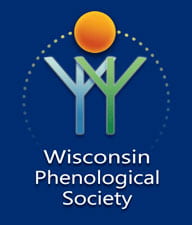WPS Membership Form
Purpose – Organization – History
Download the form: doc (23 kb), or pdf (9kb).
What Is Phenology?
Phenology has to do with the way that living things are related to their environment. It is the science of the relationship between the changes that take place in certain plants, animals and insects as they develop and the changes that take place in the natural environment, particularly weather and seasonal changes. An easier way to define phenology is to give some examples. We hear phenological phrases all our lives. For example: “April showers bring May flowers”; ” a Swarm of bees in June is worth a silver spoon, but a swarm of bees in July isn’t worth a fly”; “plant lima beans when the maple trees unfold their first leaves”; “plant root crops during the moon’s third quarter” (which is false but all the others are true).
From these simple observations we can go to sophisticated rules such as this: “Spray for spittlebugs when the sum of the degree-days reaches 25.” ( In this case a degree day is the number of degrees the average daily temperature exceeds 50o). If we could establish the fact that a specific plant flowers when the degree-days reaches 25 then we could have a perfect phenological indicator to tell us when to spray for spittle bugs. We could forget about degree-days and just start spraying when that flower blossoms.
To really make phenology work for us we need to collect information on many such natural events, over a large geographic area and over a long period of time. This is the only way to discover new “rules” which will be simple yet dependable. These surface data can also be of benefit to large-scale global change studies, and provide valuable comparisons for information observed from earth-orbiting satellites. A whole network of observers is required to carry out the hundreds of observations that are necessary in such a program. This requires organization, and we have that organization-the Wisconsin Phenological Society (WPS).
How did the WPS start?
In 1959, a number of individuals that had a common interest in phenology met informally to consider ways of stimulating wider interest and study in the field. The first official meeting of the Wisconsin Phenological Society was held on January 23, 1963 making it the first organization of phenologists in the United States. In 1964 the Society became affiliated with the Wisconsin Academy of Sciences, Arts and Letters. The Society’s administrative office is currently in Milwaukee.
What does the WPS do?
The Wisconsin Phenological Society promotes and encourages the study phenology in Wisconsin by organizing a network of observers who collect phenological data. The data is entered in a database which can then be studied and analyzed. The WPS also publishes reports prepared by its members and distributes an annual newsletter. Meetings of the WPS are held annually.
Who can be a member of the WPS?
There are no special skills required to be a member of the WPS and anyone interested in phenology is welcome to join. If you are interested in becoming a member fill out the form and mail it with a check or money order (no cash please) to the address listed below. Membership includes an observation kit and subscription to the annual newsletter. Dues are used primarily to defray the cost of mailing the newsletter.

